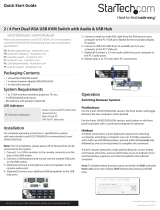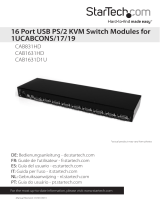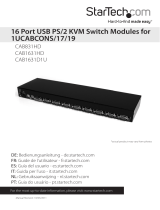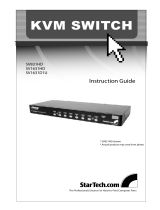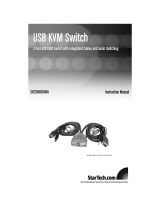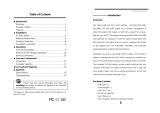
Instruction Manual
6
Non-volatile memory stores all name entries until you change, even if the unit is
powered down.
Selecting Computers for Autoscan
Function key <F2> - Use this key to switch the eye mark (
N
) of a computer on or
o. First, use the < > and < > arrow keys to highlight it, then press <F2> to switch
its eye mark on or o. If Scan Type reads ‘Ready PC +
N
‘, only the power-on and eye
mark selected computers will be displayed sequentially in Scan mode.
Locking Devices (Slave or computer)
Function key <F3> - To lock a device (a computer or a Slave) from unauthorized
access, use Security. Security is eective for only one device (a computer or a
Slave). To lock a device, use the < > and < > arrow keys to highlight it, then
press <F3>. Now, enter up to 4 characters (‘A’~’Z’, ‘0’~‘9’, ‘-‘) followed by <ENTER>
as new password. A Security enabled device is marked with a lock (Ï)following its
port number. To permanently disable the security function from a locked device,
highlight it, press <F3> then enter the password.
If you want to access the locked device temporarily, simply highlight it and press
<ENTER>. The OSD will prompt for the password. After entering the correct password,
you are allowed to use the device. This device is automatically re-locked once you
switch to another one. During Scan mode, OSD skips the security-enabled device.
Advanced Functions
Function key <F4> - More functions are available by hitting <F4>. A new screen pops
up displaying more functions as described below. Most of them are marked with a
triangle ( ►) indicating there are options to choose from. Using the < > and < >
arrow keys, select the functions and press <ENTER>. Available options will be shown in
the middle of the screen. Again, using the < > and < > arrow keys to view options,
then press <ENTER> to select it. You can press <ESC> to exit at any time.
Auto Scan
In this mode, the Console automatically switches from one powered computer to
the next, sequentially in a xed interval. During Auto Scan mode, the OSD displays
the name of the selected computer. When Auto Scan detects any keyboard or
mouse activity, it suspends the scanning until activity stops; it then resumes with
the next computer in sequence. To abort Auto Scan mode, press the left <CTRL>
twice, or, press any front button. Scan Type and Scan Rate set the scan pattern. Scan
Type (<F4>:More\Scan Type) determines if scanned computers must also be eye
mark selected. Scan Rate (<F4>:More\Scan Rate) sets the display interval when a
computer is selected before selecting the next one.





















